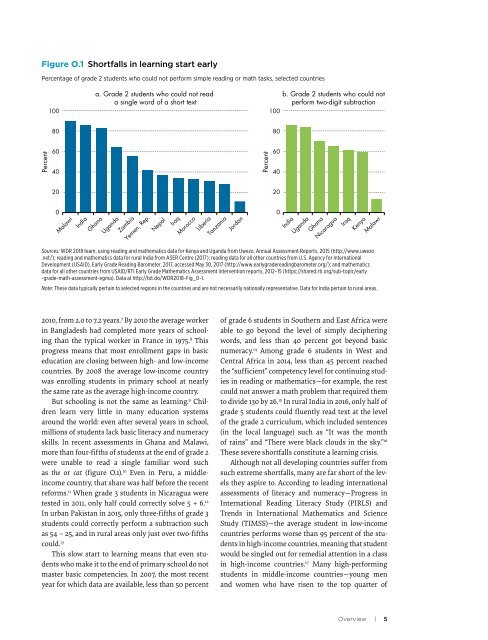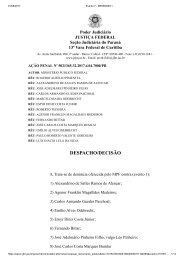Brasil só deve dominar Leitura em 260 anos, aponta estudo do Banco Mundial Relatorio Banco Mundial _Learning
Create successful ePaper yourself
Turn your PDF publications into a flip-book with our unique Google optimized e-Paper software.
Figure O.1 Shortfalls in learning start early<br />
Percentage of grade 2 students who could not perform simple reading or math tasks, selected countries<br />
100<br />
a. Grade 2 students who could not read<br />
a single word of a short text<br />
100<br />
b. Grade 2 students who could not<br />
perform two-digit subtraction<br />
80<br />
80<br />
Percent<br />
60<br />
40<br />
Percent<br />
60<br />
40<br />
20<br />
20<br />
0<br />
Malawi<br />
India<br />
Ghana<br />
Uganda<br />
Zambia<br />
Y<strong>em</strong>en, Rep.<br />
Nepal<br />
Iraq<br />
Morocco<br />
Liberia<br />
Tanzania<br />
Jordan<br />
India<br />
Uganda<br />
Ghana<br />
Nicaragua<br />
Iraq<br />
Sources: WDR 2018 team, using reading and math<strong>em</strong>atics data for Kenya and Uganda from Uwezo, Annual Assessment Reports, 2015 (http://www.uwezo<br />
.net/); reading and math<strong>em</strong>atics data for rural India from ASER Centre (2017); reading data for all other countries from U.S. Agency for International<br />
Development (USAID), Early Grade Reading Barometer, 2017, accessed May 30, 2017 (http://www.earlygradereadingbarometer.org/); and math<strong>em</strong>atics<br />
data for all other countries from USAID/RTI Early Grade Math<strong>em</strong>atics Assessment intervention reports, 2012–15 (https://shared.rti.org/sub-topic/early<br />
-grade-math-assessment-egma). Data at http://bit.<strong>do</strong>/WDR2018-Fig_O-1.<br />
Note: These data typically pertain to selected regions in the countries and are not necessarily nationally representative. Data for India pertain to rural areas.<br />
0<br />
Kenya<br />
Malawi<br />
2010, from 2.0 to 7.2 years. 7 By 2010 the average worker<br />
in Bangladesh had completed more years of schooling<br />
than the typical worker in France in 1975. 8 This<br />
progress means that most enrollment gaps in basic<br />
education are closing between high- and low-income<br />
countries. By 2008 the average low-income country<br />
was enrolling students in primary school at nearly<br />
the same rate as the average high-income country.<br />
But schooling is not the same as learning. 9 Children<br />
learn very little in many education syst<strong>em</strong>s<br />
around the world: even after several years in school,<br />
millions of students lack basic literacy and numeracy<br />
skills. In recent assessments in Ghana and Malawi,<br />
more than four-fifths of students at the end of grade 2<br />
were unable to read a single familiar word such<br />
as the or cat (figure O.1). 10 Even in Peru, a middleincome<br />
country, that share was half before the recent<br />
reforms. 11 When grade 3 students in Nicaragua were<br />
tested in 2011, only half could correctly solve 5 + 6. 12<br />
In urban Pakistan in 2015, only three-fifths of grade 3<br />
students could correctly perform a subtraction such<br />
as 54 – 25, and in rural areas only just over two-fifths<br />
could. 13<br />
This slow start to learning means that even students<br />
who make it to the end of primary school <strong>do</strong> not<br />
master basic competencies. In 2007, the most recent<br />
year for which data are available, less than 50 percent<br />
of grade 6 students in Southern and East Africa were<br />
able to go beyond the level of simply deciphering<br />
words, and less than 40 percent got beyond basic<br />
numeracy. 14 Among grade 6 students in West and<br />
Central Africa in 2014, less than 45 percent reached<br />
the “sufficient” competency level for continuing studies<br />
in reading or math<strong>em</strong>atics—for example, the rest<br />
could not answer a math probl<strong>em</strong> that required th<strong>em</strong><br />
to divide 130 by 26. 15 In rural India in 2016, only half of<br />
grade 5 students could fluently read text at the level<br />
of the grade 2 curriculum, which included sentences<br />
(in the local language) such as “It was the month<br />
of rains” and “There were black clouds in the sky.” 16<br />
These severe shortfalls constitute a learning crisis.<br />
Although not all <strong>deve</strong>loping countries suffer from<br />
such extr<strong>em</strong>e shortfalls, many are far short of the levels<br />
they aspire to. According to leading international<br />
assessments of literacy and numeracy—Progress in<br />
International Reading Literacy Study (PIRLS) and<br />
Trends in International Math<strong>em</strong>atics and Science<br />
Study (TIMSS)—the average student in low-income<br />
countries performs worse than 95 percent of the students<br />
in high-income countries, meaning that student<br />
would be singled out for r<strong>em</strong>edial attention in a class<br />
in high-income countries. 17 Many high-performing<br />
students in middle-income countries—young men<br />
and women who have risen to the top quarter of<br />
Overview | 5








